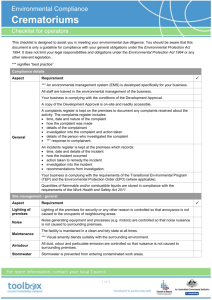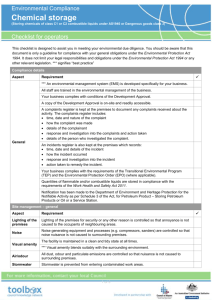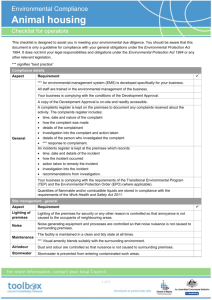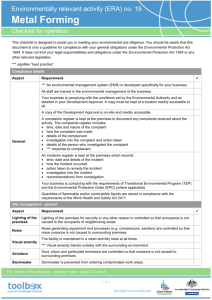Operator self assessment checklist - Wooden Product
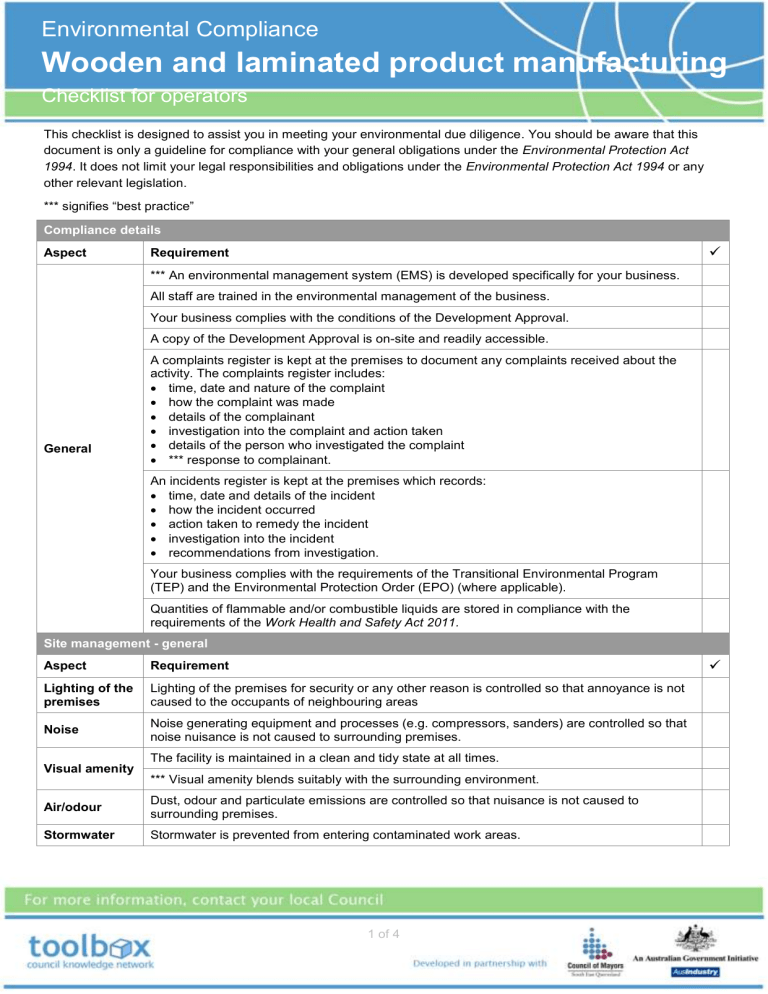
Environmental Compliance
Wooden and laminated product manufacturing
Checklist for operators
This checklist is designed to assist you in meeting your environmental due diligence. You should be aware that this document is only a guideline for compliance with your general obligations under the Environmental Protection Act
1994 . It does not limit your legal responsibilities and obligations under the Environmental Protection Act 1994 or any other relevant legislation.
*** signifies “best practice”
Compliance details
Aspect Requirement
General
*** An environmental management system (EMS) is developed specifically for your business.
All staff are trained in the environmental management of the business.
Your business complies with the conditions of the Development Approval.
A copy of the Development Approval is on-site and readily accessible.
A complaints register is kept at the premises to document any complaints received about the activity. The complaints register includes:
time, date and nature of the complaint
how the complaint was made
details of the complainant
investigation into the complaint and action taken
details of the person who investigated the complaint
*** response to complainant.
An incidents register is kept at the premises which records:
time, date and details of the incident
how the incident occurred
action taken to remedy the incident
investigation into the incident
recommendations from investigation.
Your business complies with the requirements of the Transitional Environmental Program
(TEP) and the Environmental Protection Order (EPO) (where applicable).
Quantities of flammable and/or combustible liquids are stored in compliance with the requirements of the Work Health and Safety Act 2011.
Site management - general
Requirement Aspect
Lighting of the premises
Noise
Visual amenity
Air/odour
Stormwater
Lighting of the premises for security or any other reason is controlled so that annoyance is not caused to the occupants of neighbouring areas
Noise generating equipment and processes (e.g. compressors, sanders) are controlled so that noise nuisance is not caused to surrounding premises.
The facility is maintained in a clean and tidy state at all times.
*** Visual amenity blends suitably with the surrounding environment.
Dust, odour and particulate emissions are controlled so that nuisance is not caused to surrounding premises.
Stormwater is prevented from entering contaminated work areas.
1 of 4
Wooden and laminated product manufacturing
Checklist for operators
Materials handling and storage
Aspect
Waste
Requirement
*** “First in, first out” method is used to control inventories to prevent wastage.
Materials are handled and stored according to the manufacturer’s recommendations and specifications, away from through traffic areas.
“Treated” timbers (eg CCA) are segregated to limit possible contamination from wastes, dusts, and residues.
Manufacturing process
Aspect
Air
Waste
Noise
Requirement
Emission stacks are fitted with an effective rain protection device that does not impede the discharge of exhaust gases from the stack.
Emission control equipment, such as cyclones and bag house filters, are maintained as per the manufacturer’s instructions; spare bags and filters are kept on-site.
Records kept on-site of results of regular air emissions monitoring.
*** Install monitoring ports on all stacks and other air emission discharge points.
Any material spilt over traffic areas is cleaned up immediately.
Dust is extracted using an efficient collection system such as a fabric filter dust collector or a high efficiency cyclone system.
All dust collection systems are maintained in an efficient working condition.
Sanding, cutting and sawing operations are conducted on a sealed and covered area; discharge bay is sealed to accommodate vacuuming of waste dust.
Power tools, used for sanding, cutting and sawing, are fitted with efficient dust extraction systems.
Yard area, driveways and access ways are free from any accumulated dust.
Sawdust storage bins and hoppers are designed to discharge dusts with minimal spillage and emissions.
Bins and hoppers are emptied regularly and waste disposed of in covered trucks or containers.
*** Untreated timber off cuts, shavings and sawdust are segregated from chemically treated timber wastes and collected for re-use and recycling.
Potentially hazardous wastes from CCA or other treated timber and manufactured boards (not suitable for re-use or recycling; e.g. chipboard, plywood, laminex, MDF) are disposed of to landfills via industrial waste bins by an approved waste transporter.
Workshop floors are vacuumed regularly, and dust-laden wastes bagged before placing in the industrial waste bin.
Cutting edges on all saws and cutting equipment are kept sharp and noise-damping materials used.
*** Windows and roller doors facing noise sensitive premises are sealed to minimise noise nuisance.
Silencers are fitted to air compressors, pumps, fans and blowers and other noisy machinery.
Equipment mounted on vibration isolating platforms or rubber mats.
Mechanical ventilation systems are fitted with noise-proof ducting and acoustically designed intake and exhaust openings.
All equipment and vehicles serviced and maintained to prevent any loose parts, rattling covers, worn bearings or broken components.
2 of 4
Wooden and laminated product manufacturing
Checklist for operators
Assembly and surface preparation
Aspect Requirement
Air
Adhesives/cleaning solvents are opened and mixed immediately before use; containers are resealed immediately after use.
Water
Surface preparation (sanding, filling and cleaning) is not conducted in areas where waste (such as fine dust particles) may contaminate soil and stormwater.
Wastewater from wash-down or timber/log treatments is directed to a Council approved wastewater system.
Spray painting and adhesive application
Aspect Requirement
Air
Adhesive and paint mixing is conducted in a well-ventilated room.
*** Vapour extraction inlet is positioned to draw vapours away from the operator and is connected to a filtered spray booth ventilation system.
High volume/low pressure spray guns and airless electrostatic spray guns are used.
Design of spray booths meets requirements of Australian Standard/New Zealand Standard
4114.1-2003 (Spray painting booths, designated spray painting areas and paint mixing rooms - design, construction and testing).
Filter devices for the booth are maintained as per the manufacturer’s specifications or as required to maintain effective operation.
Polymer based surface coatings, such as polyurethanes containing isocyanates, are used in a fully-enclosed Australian Standard certified booth.
Storage of potential contaminants
Aspect Requirement
General
Potential solid and liquid contaminants are stored within an adequately bunded and covered area, away from through traffic areas.
Spill clean-up equipment is available.
Procedures are in place for containment and disposal of spilt contaminants.
All containers with decanting taps are fitted with spill trays to contain drips from taps.
All bunds are constructed of compounds that are impervious to the materials stored within.
Waste management - general
Aspect
General Waste
Wastewater
Requirement
Undercover storage area is provided and maintained in a clean and tidy condition.
Waste containers are clearly labelled and located in conveniently accessible areas.
Waste is minimised on-site; only solid inert waste is disposed of to landfill.
No incineration of waste on-site.
Floor waste is captured and disposed of appropriately (e.g. sweep and bag, vacuum).
Disposal to sewer under a trade waste approval or removed by an approved waste transporter.
*** Wastewater is treated on-site and re-used.
Regulated
Wastes
All regulated wastes are removed from the premises by an approved regulated waste transporter. Records are available for inspection of the following:
Hazardous waste disposal facility dockets (when applicable).
Licensed waste transport vehicle details (when applicable).
Register of time, date, quantity, type and destination of waste removed or disposed of.
3 of 4
Wooden and laminated product manufacturing
Checklist for operators
Recycling
*** Waste, as below, is segregated for recycling and re-used on-site where possible:
Clean cardboard.
Aluminium cans and drink bottles.
Plastics.
Steel products (drums, drained steel cans).
Rags.
Waste management – site specific
Aspect Requirement
*** All recyclable liquid wastes, such as solvents, paints and thinners, are segregated for collection by an approved waste transporter.
Containers or vessels containing oils, paints, thinners, solvents and other chemicals or potential contaminants are emptied before disposal.
Waste
Dust and fibrous materials, produced from activities on-site, are collected in a nuisance-free manner and bagged prior to being placed in the industrial bin for disposal.
Gas cylinders, asbestos-containing materials or synthetic mineral fibres are removed from the site by an approved waste transporter.
Your name: Date:
4 of 4
